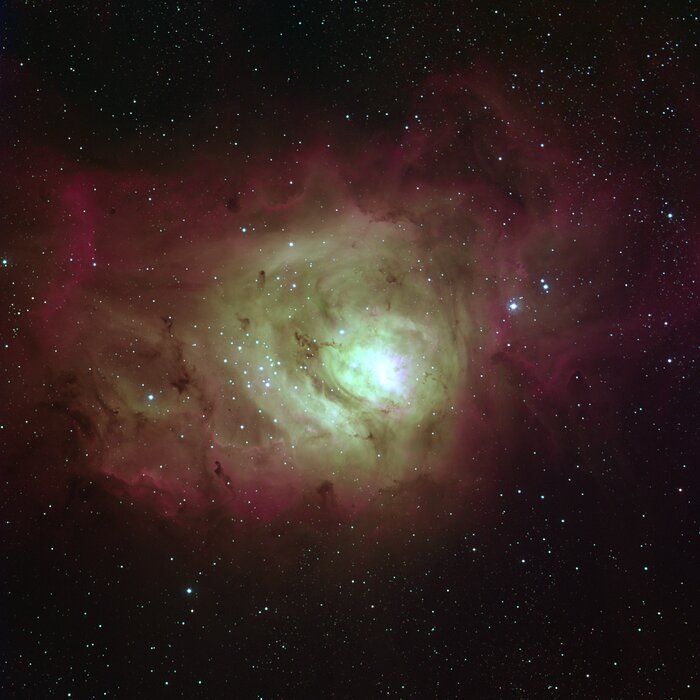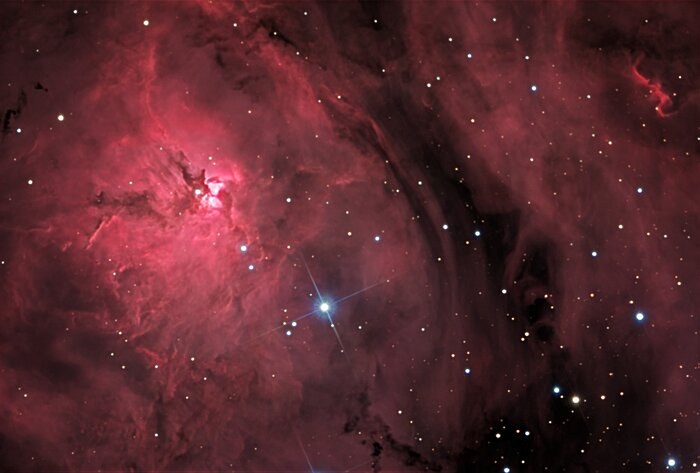The Lagoon Nebula, also known as Messier 8 (M8), is a beautiful and prominent emission nebula located in the constellation Sagittarius. It was discovered by the Italian astronomer Giovanni Hodierna before 1654. It was later independently rediscovered by the French astronomer Guillaume Le Gentil in 1747. Charles Messier included it in his catalogue as Messier 8 in 1764.
Size and Distance
M8 is located approximately 4,100 light-years away from Earth and spans a diameter of about 110 light-years. It is one of the largest and brightest nebulae in the night sky and is easily visible with binoculars and small telescopes.
Appearance
The nebula appears as a bright and expansive region of gas and dust, illuminated by the light of nearby young, hot stars. It gets its name from the dark lane of dust that runs through its center, creating the appearance of a lagoon or inlet. This lane acts like a “sandbar” within the glowing cloud of gas, creating a striking visual contrast. The dark dust is composed of tiny particles that absorb and scatter light, making it appear opaque against the bright, ionized gas surrounding it.
The dust lane is significant because it marks regions of dense material that may eventually collapse under their own gravity to form new stars. This process is a common characteristic of stellar nurseries like the Lagoon Nebula, where hot, young stars emit high-energy radiation that interacts with the surrounding gas and dust. The energetic output from these stars contributes to the overall structure and dynamics of the nebula, including the shaping of the dark dust lane

Star Formation
The Lagoon Nebula is an active star-forming region where new stars are actively being born from the surrounding gas and dust. The intense radiation and stellar winds from young, massive stars within the nebula sculpt its structure and trigger the formation of new stars in nearby clouds of gas and dust.
Like many other emission nebulae, the Lagoon Nebula primarily consists of hydrogen gas, along with other elements such as helium, oxygen, sulphur, and nitrogen. These elements are crucial for the formation of new stars within the nebula.
When areas of hydrogen gas in the nebula reach a sufficient density, they can collapse under their own gravitational pull, resulting in the formation of protostars. Helium, which is produced in the cores of stars through nuclear fusion, adds to the overall mass and gravitational forces within the nebula. Meanwhile, elements like oxygen, sulphur, and nitrogen are generated during stellar nucleosynthesis and play a crucial role in forming more complex molecules. These molecules can ultimately lead to the development of planets and other celestial bodies.
Observation
The Lagoon Nebula is a popular target for amateur astronomers due to its brightness and visual appeal. It can be observed with binoculars and small telescopes under dark skies, with larger telescopes revealing more intricate details and structure within the nebula.
M8 is ideally observed during the summer months in the Northern Hemisphere, especially from June to August, when the constellation Sagittarius reaches its peak altitude in the night sky. Coincidentally, these months align with winter in the Southern Hemisphere, allowing stargazers in both regions to appreciate this remarkable celestial object.




